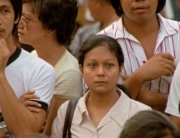In Japanese swordsmanship, the expression “one cut, one life” refers to the importance of making every movement count. For Ed Pincus, it is also a philosophy for how to live life, one that has taken on a new urgency. “Everything could be the last time. Everything counts. Everything has meaning,” when he’s faced with the diagnosis of a terminal illness.
Considered the father of first-person documentary, Pincus (Black Natchez and Diaries: 1971-1976) contacts Lucia Small (My Father, the Genius) in hopes of creating a last, personal work from two separate points of view upon learning his diagnosis of cancer. His disease, complicated by Parkinson’s, makes having a partner a necessity. In fact, the last film Pincus made was when the two filmmakers had worked together to produce a documentary about Hurricane Katrina victims (The Axe in the Attic).
Small was in the process of grieving over the sudden and violent deaths of two close friends when Pincus delivered the news of his imminent demise. Nevertheless, she agreed to participate in this final collaborative project. The raw emotional states of both filmmakers define the film as each in their own way utilizes the medium as a path to recovery.
A brief history of each filmmaker’s life is gradually revealed between discussions about the making of this one, which makes use of old photographs, home movies, and clips from their documentaries. Problematic to the process of production is Jane, Pincus’s wife of 50 years and mother of their two children (as well as co-author of Our Bodies, Ourselves). Jane understands the importance of this project to her husband, but resents the intrusion of cameras into their last months together, and she is jealous of the intimate emotional relationship between Pincus and Small. She provides a powerful presence as she vacillates between ambivalence, anger, and hurt. As Pincus and Small circumvent Jane’s displeasure, the film seems to increasingly center around her, and as a result does more to reveal the personalities of the two filmmakers than through anything that they disclose about themselves or each other.
Footage involving the progression of Pincus’s illness is unavoidable, but it is by no means the focus of this film. Rather, it is about his making the most of the time that is left. The camera catches with brilliant color and clarity the vision of someone who knows that they are witnessing everything for the last time, from the distinct beauty inherent in each season to the precious moments spent with loved ones. It leaves no doubt that through the making of this cathartic documentary, Pincus transcended his illness to savor life to the end and Small found a way to work through her grief. It does leave one wondering, however, what benefit could there possibly have been for Jane?
Also left in question is the benefit of having two points of view included in what was supposed to be Pincus’s personal documentary. Both filmmakers have an equal presence and come across as very similar in their approach to filmmaking. Any differences of opinion seem to stem primarily from a standpoint of gender, leaving one with the feeling that the inclusion of the much younger Small in this project was a way for Pincus to act once more as teacher, to bask once again in the admiration of a peer, and to bring closure to unfinished business between them.

















Leave A Comment